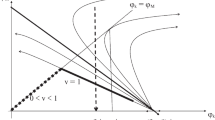Abstract
We consider the problem of modeling the investments in an imperfect capital market in which the interest on loans significantly exceeds the interest on deposits. To determine the cash flow deflator, we propose to use the Cantor–Lippman model in which the investment environment is described by a pool of stationary and replicable projects. The pool of investment projects defines the investment function, which is built as the pointwise maximum of Laplace transforms of the cash flows of investment projects. The Cantor–Lippman model of investment in an imperfect capital market allows us to build a Bellman function, which can be used to assess the financial state of the investor. We study the properties of the Bellman operator in the problem of an optimal investment strategy. It is shown that the minimum positive root of the investment function should be used as a cash flow deflator. We also study a dynamic control system describing the investment process. Modes of balanced growth are built. The Neumann growth rate and the Neumann equilibrium states are determined. A weak turnpike theorem is proved.
Similar content being viewed by others
Notes
If some project lasts less than \(n\) time periods, then we supplement the corresponding vector with zeros.
In this inequality, \(|A|\) means the number of elements contained in the set \(A\) (the cardinality of \(A\)).
REFERENCES
I. Fisher, The Rate of Interest (Macmillan, New York, 1907).
I. Fisher, The Theory of Interest (Macmillan, New York, 1930).
J. Hirshleifer, “On the theory of optimal investment decision,” J. Political Econ. 66 (4), 329–352 (1958). https://doi.org/10.1086/258057
R. M. Solow, Capital Theory and the Rate of Return (North-Holland, Amsterdam, 1963).
D. Gale, “On the theory of interest,” Am. Math. Month. 80 (8), 853–868 (1973). https://doi.org/10.2307/2319391
R. Dorfman, “The meaning of internal rates of return,” J. Finance 36 (5), 1011–1021 (1981). https://doi.org/10.1111/j.1540-6261.1981.tb01072.x
D. G. Cantor and S. A. Lippman, “Investment selection with imperfect capital markets,” Econometrica 51 (4), 1121–1144 (1983). https://doi.org/10.2307/1912055
D. G. Cantor and S. A. Lippman, “Optimal investment selection with a multitude of projects,” Econometrica 63 (5), 1231–1240 (1995). https://doi.org/10.2307/2171729
I. Adler and D. Gale, “Arbitrate and growth rate for riskless investments in a stationary economy,” Math. Finance 7 (1), 73–81 (1997). https://doi.org/10.1111/1467-9965.00023
I. M. Sonin, “Growth rate, internal rates of return and turnpikes in an investment model,” Econ. Theory 5 (3), 383–400 (1995). https://doi.org/10.1007/BF01212325
E. L. Presman and I. M. Sonin, Growth Rate, Internal Rates of Return and Financial Bubbles (TsEMI RAN, Moscow, 2000).
V. Z. Belen’kii, Economic Dynamics: Analysis of Investment Projects within the Neumann–Gale Linear Model (TsEMI RAN, Moscow, 2002) [in Russian].
M. P. Vashchenko, “The estimation of the yield of investment projects under uncertain conditions,” Math. Models Comput. Simul. 2 (1), 33–45 (2010). https://doi.org/10.1134/S2070048210010047
M. P. Vashchenko and A. A. Shananin, “Estimation of the rate of return generated by a pool of investment projects in the continuous-time model of optimal investment,” Math. Models Comput. Simul. 4 (5), 497–508 (2012). https://doi.org/10.1134/S2070048212050092
A. A. Shananin, M. P. Vashchenko, and Sh. Zhang, “Financial bubbles existence in the Cantor–Lippman model for continuous time,” Lobachevskii J. Math. 39 (7), 929–935 (2018). https://doi.org/10.1134/S1995080218070181
A. M. Rubinov, Superlinear Multivalued Mappings and Their Applications to Mathematical Economic Problems (Nauka, Leningrad, 1980) [in Russian].
Funding
This work was supported by the Russian Science Foundation (project no. 16-11-10246).
Author information
Authors and Affiliations
Corresponding author
Additional information
Translated from Trudy Instituta Matematiki i Mekhaniki UrO RAN, Vol. 25, No. 4, pp. 265 - 274, 2019 https://doi.org/10.21538/0134-4889-2019-25-4-265-274.
Translated by I. Tselishcheva
Rights and permissions
About this article
Cite this article
Shananin, A.A. Mathematical Modeling of Investments in an Imperfect Capital Market. Proc. Steklov Inst. Math. 313 (Suppl 1), S175–S184 (2021). https://doi.org/10.1134/S0081543821030184
Received:
Revised:
Accepted:
Published:
Issue Date:
DOI: https://doi.org/10.1134/S0081543821030184




